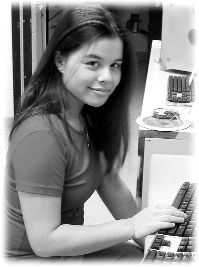
It’s a bitter-cold morning in New York City as I cross the Stuyvesant Bridge–known to the rest of the world as the TriBeCa Bridge–and hurry toward the school doors, eager to escape the knife-sharp wind. On the threshold, though, I’m stopped mid-step.
“ID card on!” bellows a security guard I’ve known since I was a freshman. I fumble in my bag, acutely conscious of how late I’m going to be for gym and of how much I detest wearing the blue card. A man who has simply nodded at me every morning of my four years at Stuyvesant High School now needs to see identification before letting me in the school.
Things have definitely changed around here.
***
Weeks and months have passed. The nightmare that was the morning of September 11 has faded into the background as much as it possibly could have. Stuyvesant High has, accordingly, returned to normal–in most ways, but certainly not all.
It starts with our morning walk down Chambers Street, when we see, down the avenues, the smoke-cloaked masses of debris. During lunch periods, students now are often chased out of the hallways, the gathering places we’ve always taken for granted. The guards are slowly beginning to relax, but we’re still careful about where to sit. We simmered over the fact that until February 1 we weren’t allowed to leave the building for lunch, a pre-September 11 privilege that we regarded as a birthright.
Those are just the daily, trivial hassles. The important changes show themselves in social studies classes, where it now takes only the barest spark to begin heated arguments over the United States’s forays in the Middle East. Sometimes, a pacifistic argument can be shut down single-handedly with an angry gesture toward the window–in the direction of the still massive mountains of twisted steel and shattered concrete that used to be the World Trade Center. “How can we possibly not retaliate,” a classmate once snapped, “when there are still 3,000 bodies lying in that pile?” The day’s lesson is invariably put on hold whenever the subject of September 11 is brought up. The teachers need the time to teach–even more than usual, as a result of the time that was lost right after the attacks–but they understand that we sometimes need the time to discuss our thoughts and emotions. Whenever anyone hears the noise of a plane nearby, there is a palpable moment of tension. That will be, I think, a hard thing to overcome.
Conflicting reports on air quality come from the Environmental Protection Agency, private air testers, and the city’s newspapers. Air-collecting stations are set up around the school; the machinery emits whirring, gurgling noises at all hours. Air testers pace the hallways. When we ask how the air in our classrooms is, they often don’t reply. The mystery makes the situation considerably more frightening. A classmate remarked caustically during a discussion once, “What exactly doesn’t cause cancer?” Perhaps it is a mark of the times that her comment made everyone grin.
***
Nevertheless, Stuy is still Stuy. Seniors are receiving their acceptance letters; the hallways are a daily scene of impromptu celebrations and rounds of hugs. Juniors are chugging through junior grind and revving up for their AP exams. The Spectator is still printing regularly, sports teams are still playing (even winning sometimes), and friends are still gathering after school in pizzerias. Everyone here was cut to the heart over the events of that terrifying fourth day of school, but we have all helped one another to go on. We share a bond that I believe no other class at Stuyvesant ever has–a bond forged in horror and tragedy, but strengthened by indelible spirit and an immortal sense of togetherness.
-Laura Krug is a senior at Stuyvesant High School in Lower Manhattan and a news editor of the Stuyvesant Spectator.


